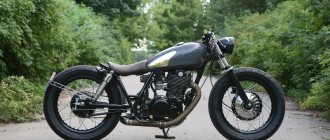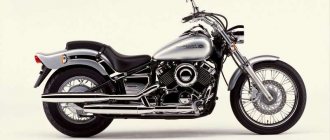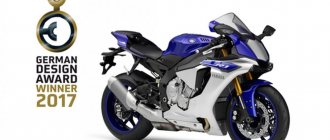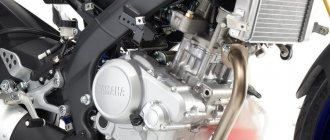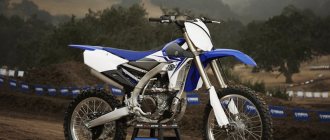The Yamaha XJR 400 is a classic road motorcycle, distinguished by its reliability and simplicity of design. Produced between 1993 and 2007. During this time it has undergone several modifications (3 generations).
The road worker is equipped with a 400 cc air-oil-cooled engine. see, manual 6-speed gearbox, OHLINS shock absorbers, Brembo brakes. This model is especially popular in the Japanese domestic market. The secret of success lies in its reliability and relatively low price.
The XJR 400 R is perfect for everyday trips around the city and for covering medium distances up to 500 km.
This motorcycle is a workhorse that copes with its tasks perfectly, requires a minimum of effort and maintenance costs, and most importantly does not let you down in difficult times and makes its rider happy every day.
The closest competitors are Honda CB 400 Super Four, Suzuki Bandit 400.
Technical characteristics of Yamaha XJR 400 R
- type - classic road motorcycle, street, classic, city bike.
- a country .
Engine:
- working volume - 400 cubic meters. cm (399 cm3).
- 4 cylinder, four stroke.
- maximum power - 39.5 kW = 53 hp. at 11000 rpm.
- torque - 35 Nm at 9500 rpm.
- bore/stroke: 55 mm x 42 mm.
- Timing - DOHC, 4 valves per cylinder, 2 upper shafts with chain drive.
- The operating order of the cylinders is 1-2-4-3.
- compression ratio - 10.7:1.
- ignition control - transistor with throttle position sensor.
- cooling system – air-oil.
- fuel supply system – carburetor without pump.
- carburetors - 4 x Mikuni BSR30 constant vacuum (CV type).
- type of lubrication system - wet sump and full-flow cleaning.
- starting system – electric starter.
Transmission, chassis, brake system:
- gearbox - manual, 6 steps.
- clutch - multi-plate in an oil bath.
- drive - chain.
- frame - duplex steel made of radial pipes.
- front suspension - telescopic fork.
- rear suspension - pendulum type with two "backpack" type shock absorbers from OHLINS, adjustable for preload.
- The angle of inclination/reach of the front fork is 26 degrees/99 mm.
- Brembo brake system (1996-1999), two-piston calipers.
- front brakes are double discs 2×298 mm.
- rear brakes - single disc, disc diameter 245 mm.
Dimensions:
- length - 2085 mm.
- width - 735 mm.
- height - 1085 mm.
- seat height – 780 mm.
- wheelbase - 1435 mm.
- minimum clearance - 115 mm.
- dry weight – 177 kg.
Wheels:
- wheels - alloy wheels, tubeless tires.
- front tire size - 110/70-17
- rear tire size - 150/60-17
Electrical equipment and lighting:
- battery type/dimensions - YTX9-BS (12 V, 8 Ah, 80 A)/152x88x110 mm.
- headlight lamp - halogen, 12 V, 60/55 W, H4 base.
- taillight lamps - 12 V, 21/5 W.
- direction indicator lamps - 12 V, 21 W.
Other information:
- gas tank volume – 20 liters.
- fuel type - gasoline AI-92 and higher.
- average fuel consumption (in the combined cycle) is about 5 liters per 100 km.
- acceleration from 0 to 100 km/h - about 4-5 seconds.
- maximum speed - 180 km/h (112 mph).
Suspension
This block can hardly be called ideal. Especially when you consider that it is not provided for domestic highways. Therefore, you should drive the equipment more carefully. The unit is made in a budget version and consists of a standard telescopic fork at the front and two rear shock absorbers.
Although the fork has no adjustments, it behaves quite decently (just in case, it is better to use thick oil). With an extreme driving style, the part works on the verge of breakdown, not to mention driving with a passenger. In addition, the behavior of the suspension is manifested by not very good handling when cornering.
Approximate prices for Yamaha XJR400
This “four hundred” in good condition can be purchased for 100-120 thousand rubles. On average, prices for this model vary from 65 thousand rubles. for a “killed” copy of the 1st-2nd generation and up to 170 thousand rubles for the latest generation XJR 400 R.
Conclusion: an unpretentious road bike with good ride quality, excellent brakes and a huge gas tank. Technically, it does not require special attention and care, so it is ideal for a beginner.
Peculiarities
The Yamaha XJR 400 was released between 1993 and 2009; the motorcycle was initially aimed at the Japanese market. The car did not gain much popularity in our country, although it did not cause any particular complaints. There are some shortcomings. However, there are plenty of advantages.
The layout of the power unit includes an air cooling system, which significantly simplifies the design, reducing maintenance costs and increasing overall reliability. Among the disadvantages are noise during engine operation and increased temperature conditions. The seat is moderately wide and not hard, providing sufficient riding comfort. The straight seating position along with the high steering wheel creates good conditions for the driver. Excellent visibility is ensured by mirrors that are practically not subject to vibration distortion.
Return of a Legend
Interestingly, when the company closed production in 2008 (30 years later) due to obsolescence, there were so many people wanting to buy this model that in 2010 it had to be returned to the production line.
The Yamaha SR400 is a legendary motorcycle that has been in demand for many decades.
In 2015 (2 years of downtime were also taken into account), the company noisily celebrated the child’s 35th birthday by releasing a limited batch.
The bike is not very familiar to Russian users (at about the same time we were offered Java), but at world auctions demand still exceeds supply . You rarely see a motorcycle in stock configuration. Many buyers take it as the basis for their own custom bike, mostly to create a cafe racer.
Modifications
During the release of the Yamaha XJR 400 (cafe racer) motorcycle, several generations have changed. Among them:
- The first modification of the XJR 400. Production began in 1993.
- In the second generation, the letter R was added to the name; the bike differs from its predecessor in the presence of golden calipers (1996).
- The design of the instrument panel has changed. The number 2 appeared in the designation (1998).
- In the next generation, the name has the number 3, the model is distinguished by new Nissan Sumitomo brake calipers (2001).
- In 2009, the era of the motorcycle in question under the code XJR 400 ends.
Yamaha XJR1200
Springs of increased rigidity are installed on the “original” shock absorbers.
Springs of increased rigidity are installed on the “original” shock absorbers.
There are no comments regarding the front brake (Brembo caliper) either in terms of efficiency or reliability. At the rear is a Tokico with a massive jet thrust. Quite often the piston warps in the cylinder and jams. So if the wear on the rear brake disc is noticeably greater than on the front ones, or it is “tarnished” in color, you should bargain with the seller for an amount equal to rebuilding the caliper with replacing all the rubber bands (PRICE?), or even the brake disc (PRICE?) , if the case is completely “clinical”. The rear brake is as effective as the front brake, so the only reasonable tuning is to install reinforced hoses (PRICE?).
Test Drive
On the road, the two-wheeled car behaves confidently. If you accelerate the equipment over 100 km/h, the lack of wind protection immediately makes itself felt. This problem can be solved by installing the front guard yourself or in a workshop.
The suspension unit is quite good - fans of a non-aggressive driving style will appreciate it. This is due to the fact that the four hundredth Yamaha, like its predecessor the XJR 1300, has good dynamics and comfort. However, it is not very suitable for sharp maneuvers, precisely because of the presence of a soft suspension. And on our roads, a bike, especially with a passenger, will sag all the way.
The braking system of a motorcycle commands great respect. It works quickly and accurately. Even high-power analogues do not always have double-disc brakes. The motorcycle in question has a similar system as standard.
Advantages and disadvantages
Despite the fact that this bike was born as a simplified and cheaper “younger brother” of the Phaser, it has much more advantages than weaknesses. The model turned out to be not only commercially successful, but also successful in all respects, and it was discontinued only so as not to create internal competition for the new bikes from the MT line.
Advantages
- Low cost of maintenance . Spare parts and consumables cost moderate money.
- Excellent dynamics and high top speed.
- High reliability and huge resource of all main components.
- A combination of excellent maneuverability and predictable engine operation.
- Versatility - the bike was equally well suited for short trips and very long ones.
Flaws
- Noisy engine . This makes it difficult to superficially diagnose potential faults.
- A lot of weight for a road 600.
- It is very difficult to drive on dirt roads.
General conclusion
Yamaha FZ 400 is a timeless motorcycle. Despite its age and discontinuation, this model continues to be popular among novice riders. Ease of operation, maintainability and successful design give confidence when using this motorcycle both in city mode and on trips over short distances (500-1000 km). Even beginners will have no questions about how to tighten the chain or get to the carburetors to clean or synchronize them. However, any repair of this motorcycle has already been discussed in detail many times on specialized forums.
Advantages
The Yamaha XJR 1200 is a bundle of energy, a hurricane, created for speeds that were prohibitive for those times. It was initially capable of flying up to 240 km/h, despite the fact that the bike was released, for a minute, back in 1999.
Despite its impressive dimensions and decent weight, the motorcycle is easy to control, it is as comfortable as possible, thanks to a comfortable, moderately soft saddle and a soft suspension that absorbs road unevenness. To this we can add the smooth traction of the engine, an excellent 5-speed gearbox and quite decent brakes, borrowed from the 1200 predecessor.
Repair and tuning
The myth that all Japanese motorcycles are complex and therefore expensive to maintain is nothing more than a myth . Such a popular Diversion is an inexpensive motorcycle, despite its excellent technical characteristics, and there is nothing overly complicated about it. Of course, this is a consequence of the attempts of Japanese engineers to reduce the cost of its production, but what difference does it make if the result is still so good?
Repair
Since there are no auxiliary systems other than ABS in this model, its repair and maintenance are quite simple. Any problems, even the most serious ones, can be dealt with at any general motorcycle service center, so there is no point in spending money on expensive trips to official dealers. And most operations can be done yourself if you are the happy owner of a garage and tools.
Spare parts
There are no problems with them - the company continues to support discontinued models for many years, and in many respects the Diversiya is unified with its brothers in the model range. Spare parts cost about the same as for all other Japanese bikes of a similar price category, that is, more expensive than for small-capacity bikes, but cheaper than for flagship models.
Tuning
There are a lot of tuning options available, if only you had enough money! The manufacturer offers something, but the choice of non-original parts is much higher. The most popular are windshields of increased height, xenon light optics and, in some cases, replacing the suspension with a more powerful one. All this is not cheap, but it is completely worth it.
Yamaha XJR1200
The frame number is traditionally stamped on the steering column.
The frame number is traditionally stamped on the steering column.
As for selling the device after a few seasons, as a rule, there are no problems. Although the motorcycle is not as popular as others, there is always a stable demand for it. XJR doesn't lose much value as it ages. The guarantee of this is the more than once mentioned reliability and unpretentiousness of the machine. And, besides, everyone knows that true classics do not age, which means they do not lose value.
The author thanks Pavel Orlov from Moscow for technical advice and the motorcycle provided for filming.
Yamaha XJR1200
We control the oil level through the inspection window on the right side of the crankcase.
We control the oil level through the inspection window on the right side of the crankcase.
Another very useful and not very burdensome procedure designed to improve the consumer properties of the device is replacing the standard “525” chain and sprockets with “530”. The higher cost of the reinforced kit will more than pay for itself with a significantly longer service life.
To conclude the review
The Japanese motorcycle Yamaha XJR 400, the characteristics of which are indicated above, has shown itself quite worthy in the relevant market. Of course, it is more suitable for Japanese roads than for domestic potholes. However, owners from post-Soviet countries have practically no complaints about the car; they find many more advantages in it than negative features. The transport appealed not only to novice motorcyclists, but also to experienced bikers who know how to squeeze out of this balanced “iron horse” everything it is capable of, and even a little more.
